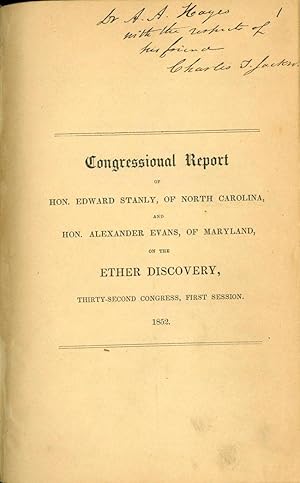Report Vindicating Rights by Jackson Charles Thomas (1 results)
Product Type
- All Product Types
- Books (1)
- Magazines & Periodicals
- Comics
- Sheet Music
- Art, Prints & Posters
- Photographs
- Maps
-
Manuscripts &
Paper Collectibles
Condition
- All Conditions
- New
- Used
Binding
- All Bindings
- Hardcover
- Softcover
Collectible Attributes
- First Edition
- Signed
- Dust Jacket
- Seller-Supplied Images
- Not Printed On Demand
Seller Location
Seller Rating
-
Report . . . vindicating the rights of Charles T. Jackson to the discovery of the anaesthetic effects of ether vapor
Published by Boston, 1853
Seller: Jeremy Norman's historyofscience, Novato, CA, U.S.A.
First Edition
[Jackson, Charles Thomas (1805-80)]. Stanley, Edward and Alexander Evans. Report to the House of Representatives of the United States of America, vindicating the rights of Charles T. Jackson to the discovery of the anaesthetic effects of ether vapor, and disproving the claims of W. T. G. Morton to that discovery. 57pp. [Washington, D. C., G.P.O.,1853.] 221 x 145 mm. Quarter morocco, antique style. Original printed front wrapper bound in.Very good copy, inscribed by Jackson on the front wrapper: "Dr. A. A. Hayes with the respects of his friend Charles T. Jackson." First Edition, issue with front cover title reading "Congressional report . . ."The "Ether Controversy," a rancorous dispute between W. T. G. Morton, Charles T. Jackson and Horace Wells over who deserved the credit for discovering inhalation anesthesia, began in 1847 and ended only with Morton's death in 1868. In late November 1851 Morton, who had hoped to make his fortune from ether anesthesia, made his third petition to Congress for a monetary reward for the discovery. Morton's claims to priority were reviewed by a congressional committee headed by William H. Bissell. The Bissell committee issued a report in favor of Morton, but two dissenting members, Edward Stanly and Alexander Evans, issued the present report supporting Jackson's priority. There are two printings of the report, one with the front wrapper title beginning with the words "Congressional report," and the other reading "The ether controversy." Jackson presented this copy to his friend Augustus A. Hayes, a Boston chemist who developed a method of distilling concentrated chloric ether for use as an anesthetic; see Warren, J. M., Surgical Operations with Cases and Observations (1867), p. 618. Wolfe, Tarnished Idol, ch. 17. .


